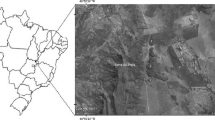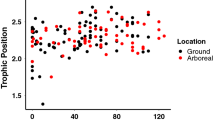Summary
Thirteen species of anurans belonging to three families forage diurnally for arthropods in the leaf litter of the lowland rainforest at the Río Llullapichis in Amazonian Perú. This paper investigates the diets and patterns of coexistence in this group of ecologically similar species. All thirteen species use the forest floor habitat without apparent differentiation. Most species take prey in proportions significantly different from those occurring in the leaf litter and comprise two specialist guilds: dendrobatids and bufonids that eat hard-bodied, slow-moving arthropods such as ants and mites; and leptodactylids that eat soft-bodied, mobile arthropods, primarily orthopterans and large spiders. Dendrobates femoralis (Boulenger) is a generalist, taking prey in proportions not significantly different from those in the leaf litter. Within specialist guilds, body sizes of species vary and are correlated with the size of prey taken. Foraging behavior and predator defense also correlate with the type and sizes of prey taken. Ant specialists tend to be poisonous and active searchers, taking many small prey per day. Non-ant specialists are cryptic, sit-and-wait foragers that take few large prey per day. Similarity in diet within guilds tends tobe lowest in the dry season when food is less abundant, suggesting that food is in short supply in the dry season.
Similar content being viewed by others
References
Abrams, P.: Limiting similarity and the form of the competition coefficient. Theoretical Population Biology 8, 356–375 (1975)
Andrews, R.M., Rand, A.S., Guerrero, S.: Regulation of population size in a tropical lizard, Anolis limifrons (abstract). Herpetological Review 8(3) supplement, 1 (1977)
Bennett, A.F., Licht, P.: Anaerobic metabolism during activity in amphibians. Comparative Biochemistry and Physiology 48A, 319–327 (1974)
Bragg, A.N.: Some factors in the feeding of toads. Herpetologica 13, 189–191 (1957)
Caswell, H.: Predator-mediated coexistence: a nonequilibrium model. American Naturalist 112, 127–154 (1978)
Connell, J.H.: Some mechanisms producing structure in natural communities. In: Ecology and evolution of communities (M.L. Cody and J.M. Diamond, editors). Cambridge, Massachusetts: Belknap Press of Harvard University Press, USA 1975
Daly, J.W., Myers, C.W.: Toxicity of Panamanian poison frogs (Dendrobates): some biological and chemical aspects. Science 156, 970–973 (1976)
Duellman, W.E.: The biology of an equatorial herpetofauna in Amazonian Ecuador. The University of Kansas, Museum of Natural history Miscellaneous Publications 65, 1–352 (1978)
Enders, F.: The influence of hunting manner on prey size, particularly in spiders with long attack distances (Araneidae, Linyphiidae, and Salticidae). American Naturalist 109, 737–763 (1975)
Feldman, M.W., Roughgarden, J.: A population's stationary distribution and chance of extinction in a stochastic environment with remarks on the theory of species packing. Theoretical Population Biology 7, 197–207 (1975)
Fenchel, T.: Character displacement and coexistence of mud snails (Hydrobiidae). Oecologia (Berl.) 20, 19–32 (1975)
Fenchel, T., Kofoed, L.H.: Evidence for interspecific competition in mud snails (Hydrobiidae). Oikos 27, 367–376 (1976)
Guerrero, S., Ayala, S.C.: Hemoparásitos de algunos reptiles y anphibios de la selva amazonica del Perú. Rev. Inst. Med. trop. Sao Paulo 19, 283–288 (1977)
Hespenheide, H.A.: Prey characteristics and predator niche width. In: Ecology and evolution of communities (M.L. Cody and J.M. Diamond, editors). Cambridge, Massachusetts: Belknap Press of Harvard University Press, USA 1975
Horn, H.S., May, R.M.: Limits to similarity among coexisting competitors. Nature 270, 660–661 (1977)
Hutchinson, G.E.: Homage to Santa Rosalia or why are there so many kinds of animals. American Naturalist 93, 145–159 (1959)
Inger, R.F., Colwell, R.K.: Organization of continguous communities of amphibians and reptiles in Thailand. Ecological Monographs 47, 229–253 (1977)
Inger, R.F., Marx, H.: The food of amphibians. Exploration du Parc national de l'Upemba 64. Mission G.F. de Witte et al., Imprimerie Hayes, Brussels, Belgium (1961)
Jacobs, J.: Quantitative measurement of food selection: a modification of the forage ratio and Ivlev's electivity index. Oecologia 14, 413–417 (1974)
Janzen, D.H.: Sweep samples of tropical foliage insects: description of study sites, with data on species abundances and size distributions. Ecology 54, 659–686 (1973)
Jones, K.L.: Prey size, trophic niche overlap, movement and feeding in four species of Eleutherodactylus, manuscript
Karr, J.R.: Seasonality, resource availability, and community diversity in tropical bird communities American Naturalist 110, 973–994 (1976)
Lack, D.: Darwin's finches. Cambridge University Press, Cambridge (1974)
Lawlor, L.R., Maynard-Smith, J.: The coevolution and stability of competing species. American Naturalist 110, 79–99 (1976)
Lescure, J.: L'alimentation et le comportement de prédation chez Bufo bufo (Linnaeus, 1758). Doctoral thesis. University of Paris, Paris, France (1965)
Lescure, J.: L'alimentation du Crapaud Bufo regularis Reuss et de la Grenouille Dicroglossus occipitalis (Günther) au Sénégal. Bulletin de l'I.F.A.N. 33(s), 446–466 (1971)
Levin, S.A.: Dispersion and population interactions. American Naturalist 108, 207–228 (1974)
Levins, R., Culver, D.: Regional coexistence of species and competition between rare species. Proceedings of the National Academy of Sciences, USA 68, 1246–1248 (1971)
Lloyd, M.R., Inger, R.F., King, R.W.: On the relative diversity of reptile and amphibian species in a Bornean rain forest. American Naturalist 102, 497–515 (1968)
Lüling, K.H.: Der Färberfrosch Phyllobates bicolor Bibron der Cordillera Azul (Peru). Bonner. Zool. Beitr. 22, 161–174 (1971)
MacArthur, R.H.: Species packing or what competition minimizes. Proceedings of the National Academy of Sciences of the USA 64, 1369–1371 (1969)
MacArthur, R.H.: Species packing and competitive equilibrium for many species. Theoretical Population Biology 1, 1–11 (1970)
MacArthur, R.H.: Geographical Ecology. Harper and Row. New York, New York USA (1972)
MacArthur, R.H., Levins, R.: The limiting similarity, convergence and divergence of coexisting species. American Naturalist 101, 377–385 (1967)
May, R.M., MacArthur, R.H.: Niche overlap as a function of environmental variability. Proceedings of the National Academy of Sciences of the USA 69, 1109–1113 (1972)
McNaughton, S.I., Wolf, L.L.: Dominance and the niche in ecological systems. Science 167, 131–139 (1970)
Myers, C.W., Daly, J.W., Malkin, B.: A dangerously toxic new frog (Phyllobates) used by Emberá Indians of Western Colombia, with discussion of blowgun fabrication and dart poisoning. Bulletin of the American Museum of Natural History 161, 309–365 (1978)
Oficina nacional de evaluacion de recoursos naturales: Inventario, evaluacion e integracion de los recoursos naturales de la zona del Río Pachitea. Lima, Perú (1966)
Pianka, E.R., Pianka, H.D.: The ecology of Moloch horridues (Lacertilia: Agamidae) in Western Australia. Copeia (1970), 90–103 (1970)
Polder, W.N.: Dendrobates, Phyllobates en Colostethus. Het Aquarium 46, 260–266 (1967)
Robinson, M.H., Robinson, B.: Prey caught by a sample population of the spider Argiope argentata (Araneae: Araneidae) in Panama: a year's census data. Zoological Journal fo the Linnean Society 49, 345–357 (1970)
Root, R.: The niche exploitation pattern of the blue-gray gnatcatcher. Ecological Monographs 37, 317–350 (1967)
Roughgarden, J.D.: Species packing and the competitive function with illustrations from coral reef fish. Theoretical Population Biology 5, 163–186 (1974)
Roughgarden, J.D.: Population dynamics in a stochastic environment: spectral theory for the linearized N-species Lotka-Volterra competition equations. Theoretical Population Biology 7, 1–12 (1975)
Roughgarden, J.D.: Resource partitioning among species—a coevolutionary approach. Theoretical Population Biology 9, 388–424 (1976)
Roughgarden, J.D., Feldman, M.: Species packing and predation pressure. Ecology 56, 489–492 (1975)
Schoener, T.W.: Resource partitioning in ecological communities. Science 189, 27–39 (1974a)
Schoener, T.W.: Competition and the form of habitat shift. Theoretical Population Biology 6, 265–301 (1974b)
Schoener, T.W.: Some methods for calculating competition coefficients from resource-utilization spectra. American Naturalist 108, 332–340 (1974c)
Schoener, T.W.: Alternatives to Lotka-Volterra competition: models of intermediate complexity. Theoretical Population Biology 10, 309–333 (1976)
Schoener, T.W., Janzen, D.H.: Notes on environmental determinants of tropical versus temperate insect size patterns. American Naturalist 102, 207–224 (1968)
Sexton, O.J., Heatwole, H., Knight, D.: Correlation of microdistribution of some Panamanian reptiles and amphibians with structural organization of the habitat. Carribean Journal of Science 4, 261–295 (1964)
Siegel, S.: Nonparametric statistics for the behavioral sciences. pp. 1–312. McGraw-Hill Book Co. New York, New York, USA (1956)
Silverstone, P.A.: A revision of the poison-arrow frogs of the genus Dendrobates Wagler. Natural History Museum of Los Angeles County Science Bulletin 21, 1–55 (1975)
Silverstone, P.A.: A revision of the poison-arrow frogs of the genus Phyllobates Bibron in Sagra (Family Dendrobatidae). Natural History Museum of Los Angeles County Science Bulletin 27, 1–53 (1976)
Slatkin, M.: Competition and regional coexistence. Ecology 55, 128–34 (1974)
Smith, J.N.M., Grant, P.R., Grant, B.R., Abbott, I.J., Abbott, L.K.: Seasonal variation in feeding habits of Darwin's ground finches. Ecology 59, 1137–1150 (1978)
Strickland, A.H.: A survey of arthropod soil and litter fauna of some forest reserves and cacao estates in Trinidad. J Animal Ecology 14, 1–11 (1945)
Svardson, G.: Competition and habitat selection in birds. Oikos 1, 157–174 (1974)
Toft, C.A., Duellman, W.E.: Anurans of the lower Río Llullapichis, Amazonian Perú: a preliminary analysis of community structure. Herpetologica 35, 71–77 (1979)
Toft, C.A., Levings, S.: Seasonal trends in litter arthropod populations. In: Proceedings of the IV International Symposium of Tropical Ecology (H. Wolda, editor). (In press)
Tokuyama, T., Daly, J., Witkop, B.: The structure of batrachotoxin, a steriodal alkaloid from the Colombian arrow poison frog, Phyllobates aurotaenia and partial synthesis of batrachotoxin and its analogs and homologs. Journal of the American Chemical Society 91, 3931 (1969)
Turelli, M.: A reexamination of stability in randomly varying versus deterministic environments with comments on the stochastic theory of limiting similarity. Theoretical Population Biology 13, 222–246 (1978)
Werner, E.E.: Species packing and niche complementarity in three sunfishes. American Naturalist 111, 553–578 (1977)
Wiens, J.A.: On competition and variable environments. Scientific American 65, 590–597 (1977)
Zaret, T., Rand, A.S.: Competition in tropical stream fishes: support for the competitive exclusion principle. Ecology 52, 336–342 (1971)
Author information
Authors and Affiliations
Rights and permissions
About this article
Cite this article
Toft, C.A. Feeding ecology of thirteen syntopic species of anurans in a seasonal tropical environment. Oecologia 45, 131–141 (1980). https://doi.org/10.1007/BF00346717
Received:
Issue Date:
DOI: https://doi.org/10.1007/BF00346717




